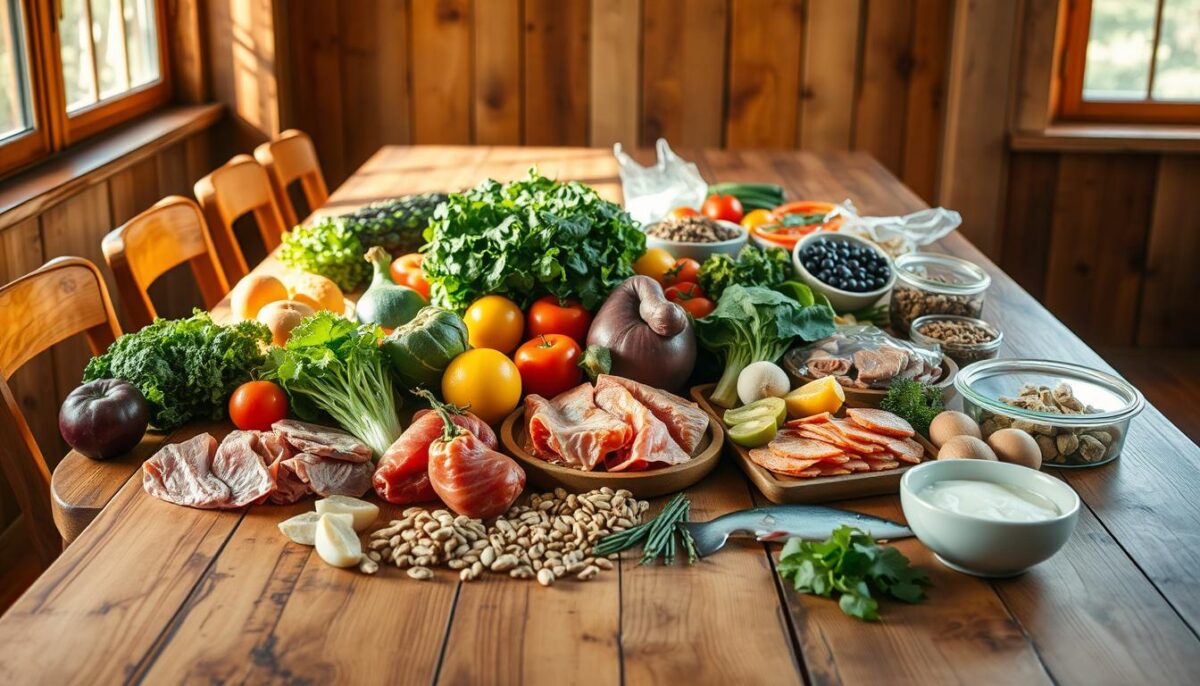How to Eat Your Way Across America’s Most Iconic Highway
June 3, 2025
Top 6 Keto and Paleo Recipes That Define Clean Eating in the US
June 4, 2025Did you know that 1 in 3 Americans have tried a high-fat, low-carb eating plan in the past five years? I nearly spilled my coffee when I first read that stat. It reminded me of my friend Jen, who once joked that her kitchen was a “no-carb zone” after switching to a meat-and-veggies-only lifestyle. She’d wave away bread baskets like they were radioactive—yet within months, her energy levels and focus transformed completely.
This shift isn’t just about skipping pasta. For decades, we were told to fear fats and load up on grains. Now, research reveals that prioritizing proteins and vegetables while cutting processed foods might actually reduce risks for conditions like diabetes. I’ve seen friends ditch counting calories to focus on food quality instead—roasting salmon with avocado oil or swapping cereal for scrambled eggs packed with nutrients.
What’s driving this change? Science plays a big role. Studies show these dietary patterns can stabilize blood sugar and support weight management. But it’s also cultural—people crave simplicity in nutrition. Choosing whole foods over packaged products feels empowering, even if it means saying no to that muffin at breakfast meetings.
In this article, we’ll unpack how these eating styles went from fringe to mainstream. You’ll learn practical tips for making them work long-term, plus how to navigate grocery aisles without feeling overwhelmed. Let’s find out if cutting carbs could be your key to feeling your best.
Key Takeaways
- High-fat, low-carb eating plans have surged in popularity due to their potential health benefits and simplicity.
- Modern diets focus on whole foods like vegetables, proteins, and healthy fats instead of processed options.
- Scientific studies link these nutritional approaches to improved blood sugar control and weight management.
- Cultural shifts toward food quality over calorie counting drive ongoing interest in these lifestyles.
- Practical adaptation strategies make these diets sustainable for everyday life.
Introduction to the Keto and Paleo Phenomenon
I first realized something had shifted when my grocery store’s cauliflower display tripled overnight. Suddenly, everyone from coworkers to cousins raved about swapping rice for riced vegetables. My own experiments began after reading a study showing low-carb diets could improve metabolic health—a stark contrast to the fat-free frenzy of my teenage years.
My Personal Journey Into Health Trends
Three years ago, I started tracking how different foods affected my energy. Reducing processed snacks and increasing vegetables and healthy fats felt revolutionary. Friends shared similar stories—one ditched afternoon slumps by prioritizing protein-rich meals, another reversed prediabetes markers through carb moderation.
Understanding the Rise in American Wellness
Research reveals 42% of U.S. adults now prioritize whole foods over calorie counting. Platforms like Instagram amplified this shift—#LowCarbLife has over 4 million posts showcasing avocado toast variations and zucchini noodle hacks. Nutritionists increasingly endorse nutrient-dense eating, noting benefits like stabilized blood sugar and reduced inflammation.
What makes these patterns stick? They simplify choices in our overwhelming food landscape. Instead of debating point systems, people focus on real ingredients. As one blogger told me: “Eating should empower, not confuse.” This mindset fuels lasting change better than any fad.
Foundations of the Keto Diet
When I first heard my body could fuel itself on fat, I thought it sounded like science fiction. The ketogenic approach flips traditional nutrition advice by prioritizing fats over carbs. My nutritionist friend put it simply: “It’s not about starving—it’s about retraining your metabolism.”
Understanding Ketosis and Low-Carb Living
Ketosis occurs when carb intake drops below 50 grams daily. Your liver then converts fat into ketones for energy. I tracked my macros for weeks before noticing mental clarity improvements—a common benefit reported in Annals of Internal Medicine studies.
This metabolic shift impacts weight management. Research shows low-carb diets may help reduce insulin spikes linked to diabetes risk. My grocery list transformed to focus on three key elements:
| Aspect | Traditional Diet | Ketogenic Diet |
|---|---|---|
| Carb Intake | 45-65% of calories | 5-10% of calories |
| Primary Energy | Glucose | Ketones |
| Fat Consumption | Limited | 70-80% of intake |
Choosing the Right Fuel Sources
Not all fats are created equal. I learned to prioritize avocado oil for cooking and wild-caught fish for omega-3s. Leafy greens became my go-to carb source—spinach packs more nutrients per gram than apples.
Here’s what stays in my kitchen now:
| Recommended | Avoid |
|---|---|
| Avocados | Grains |
| Nuts | Sugary fruits |
| Grass-fed meats | Processed oils |
The beauty lies in customization. As one chef told me: “Roast Brussels sprouts in bacon fat—it’s science you can taste.” This balance makes the plan sustainable beyond quick weight loss goals.
Journeying Through the Paleo Diet
What if your grocery cart could time travel? That’s essentially the premise behind ancestral eating patterns. This approach focuses on whole ingredients our hunter-gatherer ancestors might recognize—foods that fueled human survival for millennia.

Embracing Whole Foods the Caveman Way
The core idea is simple: eat what nature provides. I cleared my pantry of anything with unpronounceable ingredients and filled it with grass-fed meats, wild-caught fish, and rainbow-colored produce. My nutritionist friend summed it up: “If it doesn’t grow or roam freely, it’s not on the menu.”
Modern eating often relies on packaged goods. Compare that to ancestral patterns:
| Aspect | Modern Diet | Ancestral Approach |
|---|---|---|
| Grains | Refined flour | None |
| Dairy | Processed cheese | Limited raw options |
| Sweeteners | High-fructose syrup | Occasional honey |
Navigating Paleo Shopping Strategies
Grocery runs became easier once I focused on perimeter sections—produce, meats, and nuts. I keep this cheat sheet in my wallet:
| Stock Up | Skip |
|---|---|
| Pasture-raised eggs | Breakfast cereals |
| Fresh berries | Granola bars |
| Cashew butter | Peanut butter (added sugars) |
Prepping roasted veggies and grilled proteins every Sunday cut my weekday cooking time in half. Within weeks, I noticed fewer energy crashes and better digestion—proof that simple swaps can yield real results.
Intermittent Fasting: A Complementary Approach
What if changing when you eat could be as powerful as changing what you eat? This question haunted me during my first week of time-restricted eating. I’d always focused on food quality, but timing added a new layer to my health journey.
Establishing a 16-8 Routine
The 16:8 method simplifies fasting: eat within an 8-hour window, fast for 16. My noon-to-8pm schedule surprised me—mornings became sharper without breakfast fog. Studies in Cell Metabolism show this approach helps regulate blood sugar and may reduce diabetes risk.
Here’s how popular fasting styles compare:
| Method | Eating Window | Key Benefit |
|---|---|---|
| 16:8 | 8 hours | Improved insulin sensitivity |
| 5:2 | Normal eating 5 days | Weight management |
| OMAD | 1 meal daily | Simplified routine |
My biggest challenge? Late-night cravings. I swapped chips for herbal tea and found hunger waves pass in 20 minutes. Now I use fasting days to reset after holidays—it’s like a system reboot for my metabolism.
Pairing this with whole-food diets amplifies results. Research shows combining fasting with high-protein meals preserves muscle mass during weight loss. Start slowly: delay breakfast by 30 minutes daily until you hit your target window.
Remember, flexibility matters. If a friend’s birthday dinner falls outside your schedule, adjust your window that day. Consistency over perfection creates lasting change.
Balancing Nutrients: Benefits and Drawbacks
Three months into my dietary overhaul, my bloodwork told a story my jeans already knew. While energy levels soared and stubborn weight finally shifted, I discovered nutritional balance isn’t a simple equation. This journey taught me that even the most intentional eating plans require careful calibration.

Real Health Benefits I’ve Experienced
My morning fog lifted within weeks of prioritizing protein and healthy fats. A recent study in The American Journal of Clinical Nutrition echoes this—participants focusing on nutrient-dense foods reported 23% more sustained energy than low-fat dieters. Blood sugar stability became my new normal, with fasting glucose levels dropping into optimal ranges.
Challenges and Considerations in Dietary Shifts
Early on, I battled leg cramps from magnesium deficiency—a common pitfall when cutting grains. My nutritionist warned: “What you remove matters as much as what you keep.” Tracking macros helped me avoid overloading on saturated fats while ensuring enough fiber.
Here’s what worked for me:
- Rotating protein sources (salmon, lentils, chicken)
- Adding flaxseed to smoothies for omega-3s
- Testing blood markers quarterly
The biggest lesson? Listen when your body whispers—like craving citrus signaled need for vitamin C. With strategic tweaks, what began as dietary restrictions became sustainable nourishment.
Keto paleo wellness trends: The Modern Lifestyle Shift
Scrolling through my feed last Tuesday, I counted seven avocado-packed recipes before reaching the third post. This digital landscape has become a nutrition classroom where #FoodTok tutorials get more views than celebrity gossip. Platforms now shape choices as much as doctors’ advice—a shift I witnessed firsthand when my sister swapped her cereal for chia pudding after watching a 60-second reel.
Social Media’s Role in Shaping Diet Culture
Influencers turned meal prep into prime-time entertainment. @CleanEatsKaren, a mom of three with 800K followers, makes spiralized zucchini noodles look gourmet. Her “5-Ingredient Friday” series simplifies high-protein meals—proof that relatable content drives change better than textbook guidelines.
Online communities erased the stigma around dietary restrictions. Facebook groups like “Low-Carb Living” connect millions sharing blood sugar success stories. These spaces normalize alternative eating patterns through shared experiences rather than clinical jargon.
| Platform | Content Type | Engagement Rate |
|---|---|---|
| Recipe Reels | 12% higher than average | |
| TikTok | 30-Day Challenges | 2.3M hashtag uses |
| YouTube | Meal Prep Guides | 45% completion rate |
Grocery stores now stock cauliflower pizza crusts and coconut wraps—direct responses to viral food trends. My local market manager told me: “We track Pinterest searches to plan inventory.” This real-time feedback loop between screens and shelves keeps diets dynamic.
Accessibility fuels participation. Free macro calculators and Instagram polls help people customize plans without nutritionists. While misinformation exists, the democratization of health knowledge empowers smarter choices. As one follower messaged me: “I learned about resistant starches from a TikTok—now my salads keep me full for hours.”
Incorporating Other Dietary Trends
My pantry overhaul last spring taught me there’s no universal path to better eating. While high-fat plans work for some, others thrive on plant-based meals or Mediterranean-inspired plates. Let’s explore how popular approaches stack up.
Comparing Vegan, Gluten-Free, and Mediterranean Options
Vegan diets eliminate animal products, focusing on plants for protein sources like lentils and tempeh. Studies show they may lower heart disease risk but require careful planning to avoid nutrient gaps. One friend reversed her prediabetes this way—though she admits craving eggs took months to fade.
Gluten-free eating targets wheat proteins, essential for those with celiac disease. Yet many adopt it hoping for weight loss, often swapping processed breads for equally sugary alternatives. As a nutritionist warned me: “Avoiding gluten doesn’t automatically make snacks healthier.”
The Mediterranean approach emphasizes olive oil, fish, and whole grains. Research links it to reduced diabetes risk and longevity. Unlike restrictive plans, it allows moderate wine and dairy—a balance I’ve seen work for busy families.
| Diet | Focus | Key Foods |
|---|---|---|
| Vegan | Plant-based | Legumes, nuts, tofu |
| Gluten-Free | Wheat elimination | Quinoa, rice, veggies |
| Mediterranean | Balanced fats | Olive oil, fish, nuts |
Customizing Your Personal Diet Plan
Your ideal eating pattern should fit like a tailored jacket—snug but flexible. Start by identifying non-negotiables: a night-shift worker might need portable meals, while a parent prioritizes kid-friendly foods.
Try these steps:
- Track meals for a week to spot patterns
- Swap one processed item daily for whole food
- Consult a dietitian before major shifts
My cousin blended approaches—Mediterranean base with ketogenic diet elements during marathon training. Her hybrid plan proves that mixing strategies often yields the best health outcomes. Remember: nutrition isn’t dogma. Your plate should evolve as you do.
Conclusion
My kitchen experiment taught me that food choices shape more than waistlines—they rewrite energy levels and redefine health. Low-carb approaches like the ketogenic diet work because they simplify eating: focus on quality proteins, ditch processed products, and let your body recalibrate. Studies linking these patterns to weight management and diabetes risk reduction convinced me faster than any influencer reel.
But here’s the truth I’ve learned: no single diet holds all answers. Your neighbor’s perfect meal plan might leave you craving snacks by noon. That’s why blending strategies often works best—maybe eggs for breakfast, lentil salads at lunch, and olive oil-roasted veggies at dinner.
Before overhauling your plate, consult a nutritionist. Blood tests revealed gaps in my own routine I’d never have spotted alone. Small tweaks—like adding chia seeds for fiber—made my plan sustainable.
Ultimately, eating well isn’t about strict rules. It’s about crafting a mosaic of foods that fuel your unique life. Start with one change: swap soda for sparkling water, or try cauliflower rice. Progress beats perfection every time.
FAQ
How does ketosis actually work for fat loss?
When I cut carbs, my body switches to burning stored fat for energy instead of glucose. This metabolic state, called ketosis, helps me shed pounds by prioritizing fat as fuel. I focus on avocados, olive oil, and grass-fed meats to stay on track.
Can I eat dairy on a whole-foods-focused plan?
It depends! While some avoid dairy, I include options like grass-fed butter or ghee in moderation. Brands like Primal Kitchen offer compliant products. Always check labels for additives if you’re aiming for clean eating.
Is intermittent fasting safe with low-carb eating?
In my experience, pairing a 16:8 fasting window with nutrient-dense meals works well. I prioritize protein like wild-caught salmon and leafy greens during eating periods to maintain energy. Consult a healthcare pro if you have conditions like diabetes.
How do I avoid nutrient deficiencies on restrictive diets?
I load up on colorful veggies, nuts, and seeds for fiber and vitamins. Supplements like magnesium or omega-3s from fish oil can fill gaps. Apps like Cronometer help me track intake to stay balanced.
Why do Instagram and TikTok push these diets so hard?
Platforms thrive on quick fixes—think #TransformationTuesday posts. I’ve seen influencers partner with brands like Bulletproof or Thrive Market. Always research claims; not every viral trend aligns with long-term health goals.
What’s better: Mediterranean or gluten-free for sustained energy?
It’s personal! Mediterranean eating emphasizes fatty fish and olive oil, which I love for heart health. Gluten-free works if you’re sensitive, but watch for processed substitutes. Mix elements of both if you’re experimenting, like I did.
Are store-bought protein bars worth it?
Many are glorified candy bars. I stick to brands like RXBAR or make my own with almond butter and collagen peptides. Check sugar content—aim for under 5g per serving to avoid crashes.
How do I handle social pressure when dining out?
I scout menus ahead for grilled proteins or veggie sides. Chains like Chipotle let you customize bowls—skip rice, add guac. Most friends respect boundaries if you explain it’s about feeling your best, not just “dieting.”



